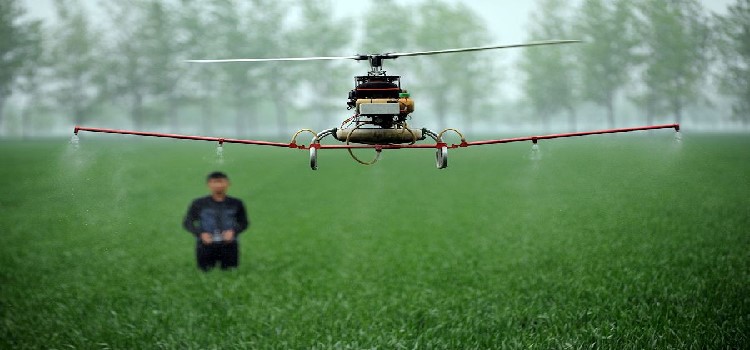
Latin America Agriculture Robots Market by Type (Driverless Tractors, Unmanned Aerial Vehicles (UAVs), Milking Robots, Automated Harvest Robots, and Others), Offering (Hardware, Software, and Services), Farming Type (Indoor Farming and Outdoor Farming), Application (Dairy Management, Irrigation Management, Harvest Management, Soil Management, Inventory Management, and Others), and End User (Field Crops, Fruits & Vegetables, Livestock, and Others) – Opportunity Analysis and Industry Forecast 2023–2030
Industry: Agriculture | Publish Date: 25-Oct-2024 | No of Pages: 88 | No. of Tables: 73 | No. of Figures: 31 | Format: PDF | Report Code : AG642
Market Definition
Latin America Agriculture Robots Market was valued at USD 0.41 billion in 2022, and is predicted to reach USD 1.49 billion by 2030, with a CAGR of 16.2% from 2023 to 2030. Agricultural robots, also known as Agribots, an automated or semi-automated machines designed to perform various tasks in the field of agriculture, such as planting, harvesting, monitoring, and spraying crops. They aim to increase efficiency, productivity, and accuracy in agriculture while reducing the need for manual labor and improving working conditions for farmers. Agribots can range from small unmanned aerial vehicles to large tractors, and combine harvesters, utilizing advanced technologies such as sensors, computer vision, and artificial intelligence.
These robots have various applications, for instance, automated planting machines can plant seeds and seedlings accurately and efficiently, reducing the time and manual labor required for this task. Agribots can monitor crops for early detection of diseases and pests, allowing for prompt and efficient treatment. Also, these robots can help farmers to practice precision agriculture, making more informed decisions about planting, fertilization, and pest control through accurate data collection and analysis.
Labor Shortage in Latin America Drives Adoption of Agricultural Robots
The shortage of skilled agricultural labor in Latin America has led to the adoption of agricultural robots as a solution to automate various tasks. As many rural workers are moving to urban areas in search of better job opportunities. This labor scarcity has prompted farmers to seek alternative solutions such as agricultural robots to automate tasks and compensate for the lack of human workers. These robots are designed to perform repetitive and labor-intensive activities like planting, harvesting, and weeding, reducing the reliance on human workers. Thus, creating significant growth in the market.
Role of Agricultural Robots in Precision Agriculture in Latin America
Precision agriculture, a rapidly growing practice in Latin America, is significantly benefiting from the integration of agricultural robots. These robots play a crucial role in implementing precision farming techniques, enabling precise planting, selective harvesting, and targeted weed control. Moreover, their ability to collect data and provide real-time analysis empowers farmers to make informed decisions and optimize resource utilization. Thus, it is expected to boost the growth of the market.
Lack of Technical Expertise and High Initial Costs
The high initial expenses needed are one of the key barriers to the deployment of agricultural robots in Latin America. Agriculture robots, as well as the essential equipment and infrastructure, demand investment. This pricing barrier may make these technologies unaffordable and inaccessible, particularly for small-scale farmers. Farmers may have difficulties in obtaining and retaining the knowledge and skills required to operate and troubleshoot this advanced robotic equipment. As a result, inadequate technical skills and expensive initial expenses restrict the adoption of agricultural robots.
Technological Advancements in Agricultural Sector
The agriculture industry in Latin America is undergoing a transformation through the adoption of artificial intelligence (AI), machine learning, and robotics. These technologies are revolutionizing the capabilities of agricultural robots, allowing them to perform diverse tasks including planting cover crops, managing various cropping systems, and providing real-time data on soil health indicators. As a result, the agricultural robotics industry in Latin America is expected to create ample opportunity for the market.
Competitive Landscape
The Agriculture Robots industry includes several market players such as Solinftec, AGCO Corporation, Autonomous Solutions Inc., Deere & Company, BouMatic Robotics BV, Naio Technologies, Agrobot, Harvest Automation, EcoRobotix, and Robotics Plus Ltd. These market players are adopting various strategies such as innovation and collaboration to maintain their dominance in the market of Latin America.
For instance, in February 2022, Solinftec, a U.S. and Brazil-based ag robotics startup introduced their latest product, the Solix Sprayer robot, capable of detecting and applying weed spray without human intervention. Through this development, the company revealed that its new offering can help farms reduce their chemical inputs and deliver a lower carbon footprint and environmental impact.
KEY BENEFITS
-
The Latin America agriculture robots market report provides a quantitative analysis of the current market and estimations through 2023-2030 that assists in identifying the prevailing market opportunities to capitalize on.
-
The study comprises a deep dive analysis of the market trend including the current and future trends for depicting the prevalent investment pockets in the market.
-
The information related to key drivers, restraints, and opportunities and their impact on the market is provided in the report.
-
The competitive analysis of the market players along with their market share in the Latin America agriculture robots market.
-
The SWOT analysis and Porter’s Five Forces model are elaborated in the study.
-
Value chain analysis in the market study provides a clear picture of the stakeholders’ roles.
LATIN AMERICA AGRICULTURE ROBOTS MARKET KEY SEGMENTS
By Component
-
Driverless Tractors
-
Unmanned Aerial Vehicles (UAVs)
-
Milking Robots
-
Automated Harvest Robots
-
Others
By Offering
-
Hardware
-
Software
-
Services
By Farming Type
-
Indoor Farming
-
Outdoor Farming
By Application
-
Dairy Management
-
Irrigation Management
-
Harvest Management
-
Soil Management
-
Inventory Management
-
Others
By End User
-
Field Crops
-
Fruits & Vegetables
-
Livestock
-
Others
KEY PLAYERS
-
GEA Group
-
CNH Industrial
-
Delaval
-
Deere & Company
-
AGCO Corporation
-
Trimble Inc.
-
Naio Technologies
-
Yanmar Holdings Co. Ltd.
-
SZ DJI Technology Co. Ltd.
-
Boumatic
-
Harvest Automation Inc
-
Autonomous Solution Inc
-
Clearpath Robotics
-
Ageagle Aerial System
-
Kubota Corporation




 Speak to Our Analyst
Speak to Our Analyst

































